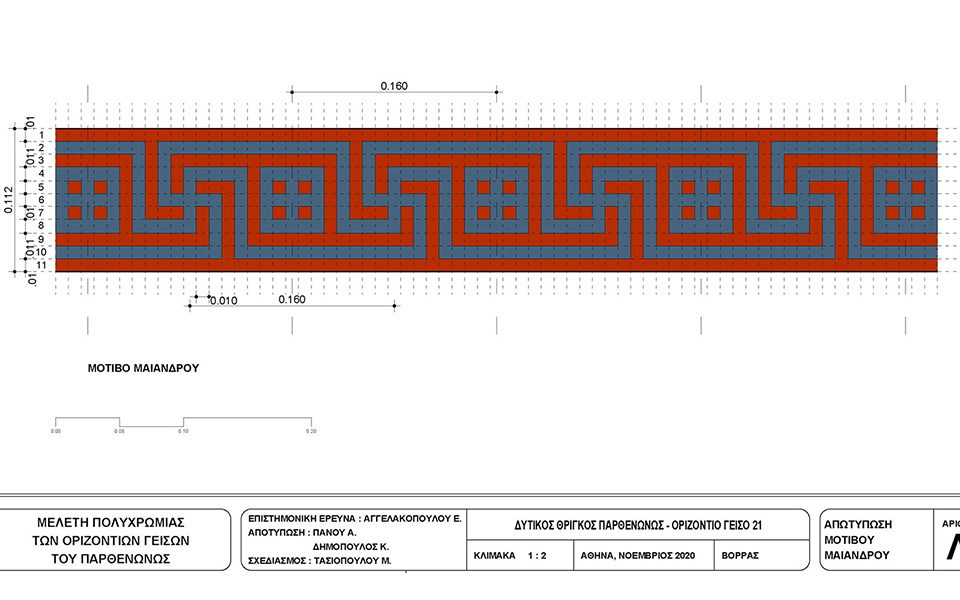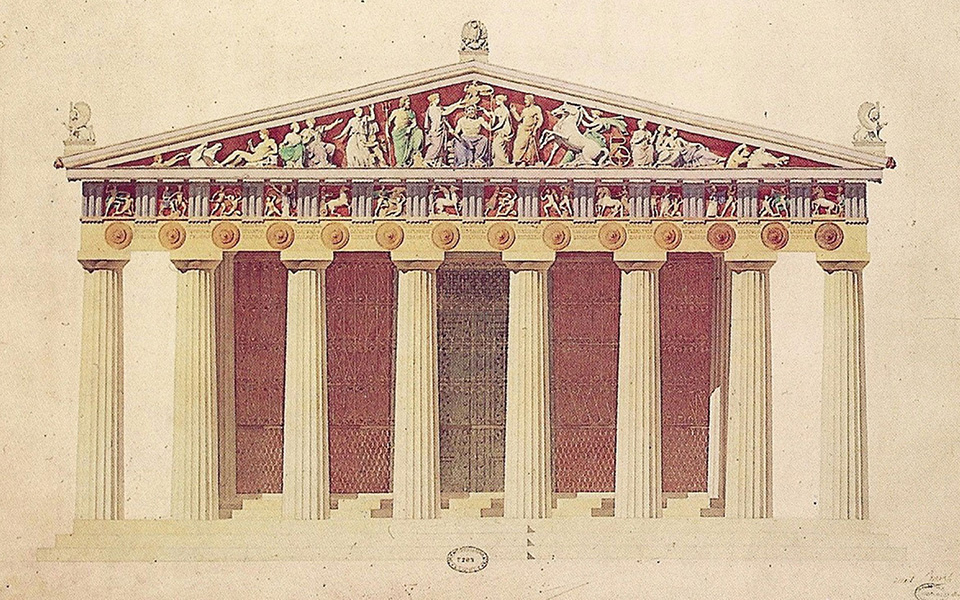The polychromy of the Parthenon – the practice of decorating architectural and sculptural elements in a variety of colors – is a well-known phenomenon. Indeed, in the 19th century, scholars who flocked to the ancient monument in Athens identified traces of colors on its surfaces, which were better preserved at the time. Some, like French architect Alexis Packard (1813-1867), Laurits Winstrup (1815-1889), and Benoît-Édouard Loviot (1849-1921), left behind detailed descriptions and drawings of the temple’s textures and colors, which continue to be significant sources of information. However, there are few things that can be said today with any scientific certainty. The actual colors used on the Parthenon, their extent and hue, as well as the origin of the pigments, remain an open debate, with scholars offering a range of different opinions.
What colors were used to paint the metopes of the Parthenon 2,500 years ago? Some argue that the background to the relief sculptures was white, others lean towards blue, while most accept red. The “band” at the top of each metope also raises questions, as does the base, not to mention the sculptural figures themselves. However, recent research by chemical engineer and head of the technical office of the Acropolis Monuments Conservation Service, Eleni Aggelakopoulou, who has been studying the polychromy of the monument since 2011, is shining new light on the subject.

© Eleni Angelakopoulou / YSMA

© Eleni Angelakopoulou / YSMA
Having already published a scientific article in the Journal of Archaeology Science in 2022, along with Professor Asterios Bakolas of the National Technical University of Athens (NTUA), focusing on the western friezes of the temple, Dr. Aggelakopoulou presented some of her new findings in a lecture last Tuesday at the Herakleidon Museum in Athens. The lecture, “In Search of the Colors of the Parthenon,” showcased her recent discoveries.
Aggelakopoulou focused on two western metopes, specifically those depicting the “Amazonomachy” (the mythical battle between the Greeks and the Amazons): metope 3 and metope 12. The research was challenging as the marble sculptures had been heavily defaced by early Christians in the 5th and 6th centuries AD. Nevertheless, the chemical engineer, along with her research team, found that metope 3, depicting a mounted Amazon and a fallen Greek warrior, had a line of intense “reddish-brown” color around the horse’s tail. Samples of its pigment were analyzed in the laboratory, along with samples from metope 12, depicting a shield-bearing Greek warrior attacking a retreating Amazon. On the base of metope 12 and at other points, the color red, this time with an orange hue, is so intense that it has piqued the interest other scholars. Aggelakopoulou has already submitted a scientific paper on the two metopes, which is currently under review.

© Eleni Angelakopoulou / YSMA
The decorative border of metope 12 also intrigued the scientist: “Elsewhere we see that it is blue, while some scholars provide information that the red continues upwards because, in some cases, the border has a meander (ancient Greek decorative motif),” she mentioned in her lecture. Her research, which utilized VIL-imaging (Visible-induced Luminescence), revealed the famous “Egyptian blue” on the border, “although it is not certain whether the entire surface was blue or if there was also painted decoration.” The research will show, as Aggelakopoulou told us, whether red ultimately prevailed on the metopes, with blue on their borders.
However, it is now certain that red and blue were used for coloring the meanders, designs of which are preserved in various parts of the Parthenon. The scientist also found that, to create the meanders, an architectural canvas (a grid of squares that “organizes” the design) was used, and their color palette included a type of blue for the main motif (the light blue of azurite) and another type (the “Egyptian blue,” which was more “electric”) for the checkerboard-like points.
Intense blue has also been identified by Aggelakopoulou on the West Frieze 4 (“where it all started,” as she mentioned in her lecture), while the range of colors she encountered elsewhere on the monument includes the emerald green of malachite, the black of charcoal, the red of hematite, and so on. Particularly significant was the confirmation of the use of beeswax as a binding material for the colors with the marble, a known method employed by ancient craftsmen called the “encaustic technique.” Aggelakopoulou’s research is gradually turning to the triglyphs, the metopes, and the cornice of the western side of the temple, to ultimately create a complete picture of the colors of the frieze.

© Eleni Angelakopoulou / YSMA
“The ‘holy grail’ of this research is establishing whether or not gold was used on the Parthenon,” Aggelakopoulou told Kathimerini, explaining that earlier references mention gold leaf in certain parts of the monument. “Nothing has been found yet, but, perhaps in the future, there will be some indication, which is something that I always keep at the back of my mind,” she continued. However, with or without gold, her work is not easy, not only because it requires “very detailed work on a huge scale,” but also because “this research has not been incorporated into any restoration program, and is carried out in addition to our contractual obligations.” “Together with my collaborators, we study the polychromy of the Parthenon mainly in our free time,” she added.
Nevertheless, she remains fascinated. “I am fascinated by the precision of the ancients,” Aggelakopoulou concludes. “They created these decorations, these jewels in the Parthenon, with tremendous detail and religious reverence. You feel it when you are close by and observe them.”
This article was previously published in Greek at kathimerini.gr.












